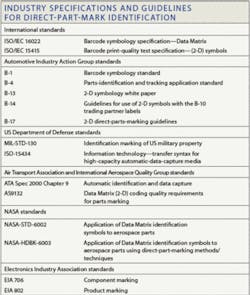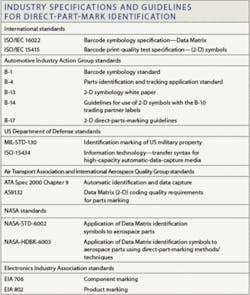Tackling industrial direct part marking
By Justin Testa
Although the automatic identification and data-collection market accounts for $7 billion in annual revenues, the industrial identification part of this market is now only approximately $35 million per year. Despite this, the industrial market is rapidly growing, especially in areas such as aerospace, automotive, semiconductor, and medical-device applications, where supply-chain management demands 100% part traceability. In these areas, the 2-D Data Matrix code has become the data marking standard of choice.
Placing this code on parts made from metal, plastic, glass, ceramic, and rubber is accomplished by using methods that include laser and electrochemical etching, dot-peening, and ink-jet printing. To read this code, manufacturers, including Cognex, Microscan, and RVSI, have developed hand-held and fixed-mount readers specifically designed to read 2-D Data Matrix code.
Although Data Matrix code supports a number of different formats and error-correction methods, all the current industry standards and guidelines for direct-part-mark identification (DPMI) are based on the ECC200 ANSI standard. These variations include specifications for different industries such as automotive, aerospace, and the Electronics Industry Association (see table). One of the most important parts of any DPMI system is the process of verification.
To ensure that the marking equipment is applying marks of consistent quality, it is necessary not only to read the code but to verify its quality. By verifying code quality downstream in the manufacturing process, any problems with the marking equipment and marking process such as poor part fixturing or a broken chisel stylus on a dot-peening machine can be rapidly identified. Feedback from such verification systems can then be fed to the operator for preventative maintenance. This is where the market needs to be educated-readers that can tolerate wide variations in the mark appearance are still required, even though the code has been verified.
Verification standards
Several verification standards are in use today, including those from the Assoication for Automatic Identification and Mobility (AIM), SEMI, and the International Aerospace Quality Group (IAQG). Developed for high-contrast paper labels, the AIM standard measures print-contrast modulation, axial nonuniformity, and unused error correction to grade marks on a scale between A and F.
Unfortunately, when applied to parts marked with dot-peening equipment, the AIM standard can miss important marking problems. A more robust standard, the IAQG 9132, is better suited to parts marked with such products, since it measures and tests dot size, dot position, and dot ovality to indicate whether a mark is excellent, acceptable, or fails. Similarly, a number of different parameters suited to semiconductor marking are addressed in the standards set forth by SEMI.
To address the problems of Data Matrix reading and verification, Cognex has recently introduced a range of hand-held and fixed-mount readers. While the company’s DataMan 6400 hand-held reader incorporates brightfield LED illumination, the DataMan 6500 uses off-axis illumination. This allows the 6400 to be used for laser and ink-jet marking and the 6500 for low-contrast codes formed by electrochemical etching and dot-peening.
Data Matrix code on parts as far as 1 to 67 in. from the reader can be identified with the 6400; parts as far as 1 in. can be read with the 6500. Priced at $2500 and $3500, respectively, the readers interface to a PC over a standard RS-232 interface and keyboard wedge. While both readers can read 2-D Data Matrix code, Cognex has not yet added any supplemental metrics to its software to allow the hand-held scanners to capture AIM, IAQG, or SEMI verification data.
For applications that require such data to be captured, the company has announced the In-Sight 5110, a fixed-mount reader that supports ISO mark quality metrics. With a serial and Ethernet interface, the unit is NEMA 6 compliant for dust and wash-down protection without the use of a separate industrial enclosure. For Data Matrix verification, the company has implemented the AIM quality metrics in the 5110 and plans to add the IAQG metrics.
As manufacturers demand 100% traceability on production lines, 2-D Data Matrix code, readers, and verification systems are becoming commonplace. Implementing such systems however, requires systems developers to overcome ‘a supermarket mentality’ where $500 scanners are commonplace. In specifying systems, developers should be aware of the number of standards used in specific applications and the manufacturers who support these standards both for reading and verification.
JUSTIN TESTA is senior vice president at Cognex, Natick, MA, USA; www.cognex.com.
Company Info
Association for Automatic Identification and Mobility, Warrendale, PA, USA
Cognex, Natick, MA, USA www.cognex.com
International Aerospace Quality Group www.iaqg.sae.org/iaqg
Microscan, Renton, WA, USA www.microscan.com
RVSI, Nashua, NH, USA www.rvsi.com
SEMI, Washington DC, USA www.semi.org

